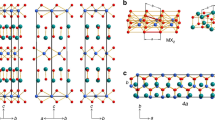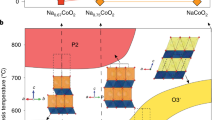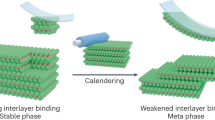Abstract
The An+1BnO3n+1 Ruddlesden–Popper homologous series offers a wide variety of functionalities including dielectric, ferroelectric, magnetic and catalytic properties. Unfortunately, the synthesis of such layered oxides has been a major challenge owing to the occurrence of growth defects that result in poor materials behaviour in the higher-order members. To understand the fundamental physics of layered oxide growth, we have developed an oxide molecular beam epitaxy system with in situ synchrotron X-ray scattering capability. We present results demonstrating that layered oxide films can dynamically rearrange during growth, leading to structures that are highly unexpected on the basis of the intended layer sequencing. Theoretical calculations indicate that rearrangement can occur in many layered oxide systems and suggest a general approach that may be essential for the construction of metastable Ruddlesden–Popper phases. We demonstrate the utility of the new-found growth strategy by performing the first atomically controlled synthesis of single-crystalline La3Ni2O7.
This is a preview of subscription content, access via your institution
Access options
Subscribe to this journal
Receive 12 print issues and online access
$259.00 per year
only $21.58 per issue
Buy this article
- Purchase on Springer Link
- Instant access to full article PDF
Prices may be subject to local taxes which are calculated during checkout




Similar content being viewed by others
References
Bibes, M., Villegas, J. & Barthelemy, A. Ultrathin oxide films and interfaces for electronics and spintronics. Adv. Phys. 60, 5–84 (2011).
Chakhalian, J., Millis, A. J. & Rondinelli, J. Whither the oxide interface. Nature Mater. 11, 92–94 (2012).
Rondinelli, J. M., May, S. J. & Freeland, J. W. Control of octahedral connectivity in perovskite oxide heterostructures: An emerging route to multifunctional materials discovery. Mater. Res. Soc. Bull. 37, 261–270 (2012).
Eckstein, J. N. & Bozovic, I. High-temperature superconducting multilayers and heterostructures grown by atomic layer-by-layer molecular beam epitaxy. Annu. Rev. Mater. Sci. 25, 679–709 (1995).
Yamamoto, H., Naito, M. & Sato, H. A new superconducting cuprate prepared by low-temperature thin-film synthesis in a Ba–Cu–O system. Jpn. J. Appl. Phys. 36, L341–L344 (1997).
Schlom, D. G., Chen, L-Q., Pan, X., Schmehl, A. & Zurbuchen, M. A. A Thin film approach to engineering functionality into oxides. J. Am. Ceram. Soc. 91, 2429–2454 (2008).
Locquet, J. P., Catana, A., Mächler, E., Gerber, J. & Bednorz, J. G. Block-by-block deposition: A new growth method for complex oxide thin films. Appl. Phys. Lett. 64, 372–374 (1994).
Ruddlesden, S. N. & Popper, P. New compounds of the K2NiF4 type. Acta Crystallogr. 10, 538–539 (1957).
Haeni, J. H. et al. Epitaxial growth of the first five members of the Srn+1TinO3n+1 Ruddlesden–Popper homologous series. Appl. Phys. Lett. 78, 3292–3294 (2001).
Lee, C-H. et al. Effect of reduced dimensionality on the optical band gap of SrTiO3 . Appl. Phys. Lett. 102, 122901 (2013).
Udayakumar, K. R. & Cormack, A. N. Structural aspects of phase equilibria in the strontium–titanium–oxygen system. J. Am. Ceram. Soc. 71, C469–C471 (1988).
Noguera, C. Theoretical investigation of the Ruddlesden–Popper compounds Srn+1TinO3n+1(n = 1 − 3). Phil. Mag. Lett. 80, 173–180 (2000).
Le Bacq, O., Salinas, E., Pisch, A., Bernard, C. & Pasturel, A. First-principles structural stability in the strontium–titanium–oxygen system. Phil. Mag. 86, 2283–2292 (2006).
McCoy, M. A., Grimes, R. W. & Lee, W. E. Phase stability and interfacial structures in the SrO–SrTiO3 system. Phil. Mag. A 75, 833–846 (1997).
Tian, W., Pan, X. Q., Haeni, J. H. & Schlom, D. G. Transmission electron microscopy study of n = 1 − 5Srn+1TinO3n+1 epitaxial thin films. J. Mater. Res. 16, 2013–2026 (2001).
Lee, C-H. et al. Exploiting dimensionality and defect mitigation to create tunable microwave dielectrics. Nature 502, 532–536 (2014).
Koster, G., Kropman, B. L., Rijnders, G. J. H. M., Blank, D. H. A. & Rogalla, H. Quasi-ideal strontium titanate crystal surfaces through formation of strontium hydroxide. Appl. Phys. Lett. 73, 2920–2922 (1998).
Nie, Y. F. et al. Atomically precise interfaces from non-stoichiometric deposition. Nature Commun. 5, 4530 (2014).
Hong, H. & Chiang, T-C. A six-circle diffractometer system for synchrotron X-ray studies of surfaces and thin film growth by molecular beam epitaxy. Nucl. Instrum. Methods Phys. Res. A 572, 942–947 (2007).
Kresse, G. & Furthmuäller, J. Efficient iterative schemes for ab initio total-energy calculations using a plane-wave basis set. Phys. Rev. B 54, 11169–11186 (1996).
Kresse, G. & Furthmuäller, J. Efficiency of ab-initio total energy calculations for metals and semiconductors using a plane-wave basis set. Comput. Mater. Sci. 6, 15–50 (1996).
Sekiguchi, S. et al. Atomic force microscopic observation of SrTiO3 polar surface. Solid State Ion. 108, 73–79 (1998).
Fisher, P. et al. A series of layered intergrowth phases grown by molecular beam epitaxy: SrmTiO2+m (m = 1 − 5). Appl. Phys. Lett. 91, 252901 (2007).
Goniakowski, J., Finocchi, F. & Noguera, C. Polarity of oxide surfaces and nanostructures. Rep. Prog. Phys. 71, 016501 (2008).
Wu, K-T., Soh, Y-A. & Skinner, S. J. Epitaxial growth of mixed conducting layered Ruddlesden–Popper Lan+1NinO3n+1(n = 1, 2 and 3) phases by pulsed laser deposition. Mater. Res. Bull. 48, 3783–3789 (2013).
Zhang, Z., Greenblatt, M. & Goodenough, J. Synthesis, structure, and properties of the layered perovskite La3Ni2O7-δ . J. Solid State Chem. 108, 402 (1994).
Nakhmanson, S. M. & Naumov, I. Goldstone-like states in a layered perovskite with frustrated polarization: A first-principles investigation of PbSr2Ti2O7 . Phys. Rev. Lett. 104, 097601 (2010).
Benedek, N. & Fennie, C. Hybrid improper ferroelectricity: A mechanism for controllable polarization–magnetization coupling. Phys. Rev. Lett. 106, 107204 (2011).
Birol, T., Benedek, N. A. & Fennie, C. J. Interface control of emergent ferroic order in Ruddlesden–Popper Srn+1TinO3n+1 . Phys. Rev. Lett. 107, 257602 (2011).
Rondinelli, J. M. & Fennie, C. J. Octahedral rotation-induced ferroelectricity in cation ordered perovskites. Adv. Mater. 24, 1961–1968 (2012).
Mulder, A. T., Benedek, N. A., Rondinelli, J. M. & Fennie, C. J. Turning ABO3 antiferroelectrics into ferroelectrics: Design rules for practical rotation-driven ferroelectricity in double perovskites and A3B2O7 Ruddlesden-Popper compounds. Adv. Funct. Mater. 23, 4810–4820 (2013).
Perdew, J. et al. Restoring the density-gradient expansion for exchange in solids and surfaces. Phys. Rev. Lett. 100, 136406 (2008).
Wahl, R., Vogtenhuber, D. & Kresse, G. SrTiO3 and BaTiO3 revisited using the projector augmented wave method: Performance of hybrid and semilocal functionals. Phys. Rev. B 78, 104116 (2008).
Acknowledgements
The authors acknowledge discussions with D. G. Schlom, K. Lee and Y. Nie, and support at the APS from H. Zhou and C. Schlepütz. S.H.C., J.A.E., A.B. and D.D.F. were supported by the US. Department of Energy, Office of Science, Materials Sciences and Engineering Division. Work performed at Argonne National Laboratory, including the Advanced Photon Source, was supported by the US Department of Energy, Office of Science, Office of Basic Energy Sciences, under contract no. DE-AC02-06CH11357. The calculations were carried out on the Fusion Cluster of Argonne’s Laboratory Computing Resource Center, at NERSC (supported by DOE), and on Argonne’s Carbon Cluster under award CNM29783 and CNM35702. D.M. and G.L. were partially supported by University of Wisconsin Materials Research Science and Engineering Center (DMR-1121288).
Author information
Authors and Affiliations
Contributions
J.H.L., Z.L., I.C.T., S.H.C., A.B., J.A.E., H.H., D.D.F. and J.W.F. developed the in situ oxide MBE system and participated in the real-time growth experiments. J.H.L., Z.L., I.C.T., D.D.F. and J.W.F. handled analysis of the experimental data. G.L., M.M., M.G., S.M.N., J.J. and D.M. were responsible for the detailed theoretical calculations related to the experiments. All authors participated in the discussion of data/analysis/conclusions and in the writing of the manuscript.
Corresponding authors
Ethics declarations
Competing interests
The authors declare no competing financial interests.
Supplementary information
Supplementary Information
Supplementary Information (PDF 1143 kb)
Rights and permissions
About this article
Cite this article
Lee, J., Luo, G., Tung, I. et al. Dynamic layer rearrangement during growth of layered oxide films by molecular beam epitaxy. Nature Mater 13, 879–883 (2014). https://doi.org/10.1038/nmat4039
Received:
Accepted:
Published:
Issue Date:
DOI: https://doi.org/10.1038/nmat4039
This article is cited by
-
Limits to the strain engineering of layered square-planar nickelate thin films
Nature Communications (2023)
-
Evolvement of atomic diffusion and corresponding effect in La0.7Sr0.3MnO3/SrTiO3 superlattice
Journal of Materials Science: Materials in Electronics (2021)
-
Sub-molecular structural relaxation at a physisorbed interface with monolayer organic single-crystal semiconductors
Communications Physics (2020)
-
Visualizing quantum phenomena at complex oxide interfaces: An atomic view from scanning transmission electron microscopy
Frontiers of Physics (2020)
-
Surface Segregation in Solid Oxide Cell Oxygen Electrodes: Phenomena, Mitigation Strategies and Electrochemical Properties
Electrochemical Energy Reviews (2020)



